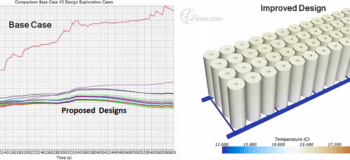Simcenter BDS 2019.2

Simcenter BDS 2019.2 is now available for download. For this release, developments and new features focus on the performance gains in the Distributed Model and the RCR model export to Simcenter Amesim.
Performance gains
The software development team worked on the optimization of the Distributed Model code, leading to significant results in computation performance improvements. Of course, it is important to note that performance will depend on the specifics of each simulation, but in some cases, an x2 speed up has been observed.
Simcenter Amesim experience
For the benefit of our users working on battery modeling at various scales, Simcenter battery solution experience has been greatly improved thanks to the ability for Simcenter Amesim to import a TBM file.
This functionality is already available within Simcenter Amesim 2019.1, released on April 2019. So in addition to the existing TBM file export to Simcenter STAR-CCM+ for 3D pack analysis, it is now possible to export to Simcenter Amesim and perform system-level 1D analysis, for thermal management, energy management, control verification & validation, etc.

This release supports RCRTable model but will support other models in the future. This provides a consistent model formulation from the cell to pack to the system level, facilitating the model exchange at various scales. The expected model performance output should be similar at all levels, and this prevents any errors when trying to translate a cell level model from one software package to a system-level model in another software package.
Minor additional features
A new filter which converts a Simcenter Battery Design Studio .out file into the equivalent program (.prg) file was added to the Simcenter Battery Design Studio 2019.2 release. This new filter adds the ability to use a previously generated .out file to drive a Simcenter Battery Design Studio simulation. This allows the verification of OutTester results, as well as provides the ability to use program file features such as limiting steps, specifying the report intervals and controlling the oven and convection settings. Additionally, simulations run times can be reduced by using the .prg format as the input format, when compared to using the original .out file.
Finally, in order to remove the confusion on reporting only the stack thermal mass in the .out file, which consists only of the electrodes stack without the packaging, the full cell thermal mass report, which consists of the electrodes stack and the packaging has now been added to the .out file. Indeed, depending on the package design, a stack can have the same thermal mass as a full cell. To remove this confusion, both thermal masses are now printed.
 A stack representation without packaging
A stack representation without packaging
For more information about Simcenter BDS, please click here and download our What’s New document below.


